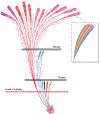Convergent Evolution, Evolving Evolvability, and the Origins of Lethal Cancer
- PMID: 32234827
- PMCID: PMC7272288
- DOI: 10.1158/1541-7786.MCR-19-1158
Convergent Evolution, Evolving Evolvability, and the Origins of Lethal Cancer
Abstract
Advances in curative treatment to remove the primary tumor have increased survival of localized cancers for most solid tumor types, yet cancers that have spread are typically incurable and account for >90% of cancer-related deaths. Metastatic disease remains incurable because, somehow, tumors evolve resistance to all known compounds, including therapies. In all of these incurable patients, de novo lethal cancer evolves capacities for both metastasis and resistance. Therefore, cancers in different patients appear to follow the same eco-evolutionary path that independently manifests in affected patients. This convergent outcome, that always includes the ability to metastasize and exhibit resistance, demands an explanation beyond the slow and steady accrual of stochastic mutations. The common denominator may be that cancer starts as a speciation event when a unicellular protist breaks away from its multicellular host and initiates a cancer clade within the patient. As the cancer cells speciate and diversify further, some evolve the capacity to evolve: evolvability. Evolvability becomes a heritable trait that influences the available variation of other phenotypes that can then be acted upon by natural selection. Evolving evolvability may be an adaptation for cancer cells. By generating and maintaining considerable heritable variation, the cancer clade can, with high certainty, serendipitously produce cells resistant to therapy and cells capable of metastasizing. Understanding that cancer cells can swiftly evolve responses to novel and varied stressors create opportunities for adaptive therapy, double-bind therapies, and extinction therapies; all involving strategic decision making that steers and anticipates the convergent coevolutionary responses of the cancers.
©2020 American Association for Cancer Research.
Conflict of interest statement
CONFLICTS OF INTEREST
KJP is a consultant and hold stocks for Cue Biopharma, Inc., Greenmark Biomedical, Inc., MEDSYN Biopharma, LLC, and Oncopia Therapeutics. LLC. KJP is a consultant for Akrevia Therapeutics, Inc., GloriousMed, Inc, Arkray, Inc., and Clinomics, Inc. KJP receives research funding from Progenics, Inc.
Figures




References
-
- Siegel RL, Miller KD, Jemal A. Cancer statistics, 2018. CA Cancer J Clin 2018;68:7–30 - PubMed
-
- Bray F, Ferlay J, Soerjomataram I, Siegel RL, Torre LA, Jemal A. Global cancer statistics 2018: GLOBOCAN estimates of incidence and mortality worldwide for 36 cancers in 185 countries. CA Cancer J Clin 2018;68:394–424 - PubMed
-
- Chaffer CL, Weinberg RA. A perspective on cancer cell metastasis. Science 2011;331:1559–64 - PubMed
Publication types
MeSH terms
Grants and funding
LinkOut - more resources
Full Text Sources
Medical
Research Materials

